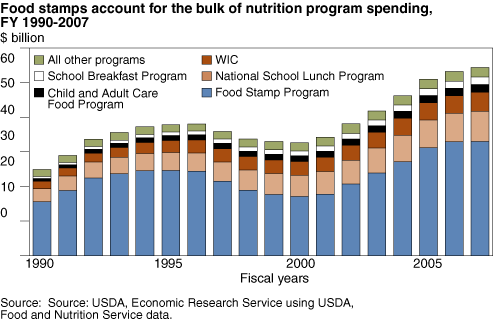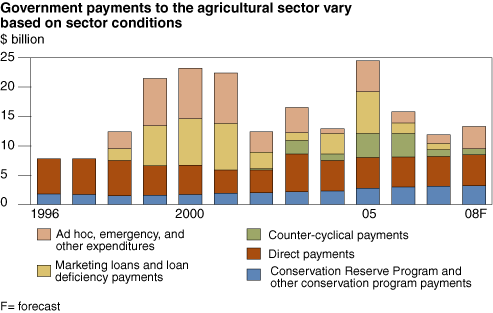Data Feature
- by Edwin Young, Victor Oliveira and Roger Claassen
- 11/1/2008
2008 Farm Act: Where Will the Money Go?
The Food, Conservation, and Energy Act of 2008 (Farm Act), enacted into law in June 2008, will govern the bulk of Federal agriculture and related programs for the next 5 years. The Act’s 15 titles include administrative and funding authorities for programs that cover income and commodity price support, farm credit, risk management, conservation, export promotion, international food assistance and agricultural development, domestic nutritional assistance (including food stamps), rural development, agriculture and food sector research, accessibility and sustainability of forests, agricultural and rural renewable energy sources, and beginning and socially disadvantaged farmers and ranchers.
Who benefits from this vast array of programs? According to Congressional Budget Office projections, over two-thirds of Farm Act-related spending will not go to farmers in fiscal years (FY) 2008-17, but to food and nutrition programs to help low-income Americans purchase food, and provide food to programs that serve children and the elderly. Less than a third of the funding (spending) in the legislation will benefit farmers through commodity programs, crop insurance, and conservation programs. The remainder (1 percent) goes to all of the other programs, such as trade promotion, farm credit, research, and energy programs. These and other USDA programs are also funded in part by annual appropriations and other legislation.
Nutrition program spending on the rise
Expenditures for USDA’s 15 domestic food and nutrition assistance programs that are funded in part through the nutrition title in the 2008 Farm Act have been increasing since FY 2000. The Food Stamp Program (renamed the Supplemental Nutrition Assistance Program (SNAP) in the 2008 Farm Act) accounted for 61 percent of total spending on nutrition programs in FY 2007. Projected increases in food stamp expenditures account for 85 percent of increased spending in the nutrition title. Food stamp use among States varied widely in FY 2007. Three States—Texas ($2.7 billion), California ($2.6 billion), and New York ($2.3 billion)—accounted for one-quarter of total U.S. benefits ($30.3 billion). However, on a per resident basis, payments were highest in the Delta and Appalachia regions.
Commodity programs benefit farmers
Eligible U.S. farmers receive support through a variety of Federal programs. The core programs provide price and income support for grains, oilseeds, fiber, dairy, and sugar. These commodity programs are intended to help farmers stabilize their incomes in the face of risks inherent in farming, and program expenditures can vary significantly from one year to the next. Other USDA programs help producers market products more effectively and farm in ways that preserve or enhance the environment. Commodity payments are concentrated in major producing areas. They are highest in the Southeastern Coastal Plain, where cotton and peanuts are produced, and along the lower Mississippi River, where cotton and rice are grown. Payments per acre are also high in the Corn Belt, where corn and soybeans are the predominant crops, in California, where rice and cotton are important, and in Arizona, where cotton is produced. Commodity program expenditures for direct and counter-cyclical payments are projected to decline under the 2008 Farm Act. Expenditures for the new Average Crop Revenue Election Program represent most of increased spending for commodity programs.
Conservation programs help farmers address environmental concerns
Conservation programs have led to a widespread reduction of soil erosion over the past seven decades. More recently established environmental programs address new challenges arising from demands for improved water and air quality, enhanced wildlife populations, water conservation, open space, carbon sequestration, and energy production and conservation. The two largest agri-environmental programs in terms of funding are the Conservation Reserve Program (CRP) and the Environmental Quality Incentives Program (EQIP). The 2008 Farm Act established the Conservation Stewardship Program (CSP), which replaces the Conservation Security Program established under the 2002 Farm Act. To participate in CSP, producers must demonstrate stewardship by showing that they have addressed at least one resource concern (e.g., soil quality or water quality) on their farm and agree to address at least one additional resource concern over the life of the 5-year contract. Payments are to be based on new practices adopted or installed under the CSP contract. The 2008 Act increases funding for programs such as EQIP and CSP that address environmental needs for land that remains in production, while reducing expenditures on the CRP, a land retirement program, by lowering the cap on total program acreage. This will likely shift spending to primary production regions such as the Corn Belt and Delta States.
You may also like:
- Supplemental Nutrition Assistance Program (SNAP) - Economic Linkages. (n.d.). U.S. Department of Agriculture, Economic Research Service.
- Conservation Programs. (n.d.). U.S. Department of Agriculture, Economic Research Service.
- Farm & Commodity Policy. (n.d.). U.S. Department of Agriculture, Economic Research Service.





